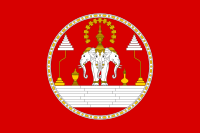| King of Laos | |
|---|---|
 | |
| Details | |
| Style | His Royal Majesty |
| First monarch | Fa Ngum |
| Last monarch | Sisavang Vatthana |
| Formation | 1353 (Kingdom of Lan Xang) |
| Abolition | 2 December 1975 (Lao People's Democratic Republic) |
| Residence | Royal Palace, Luang Prabang |
| Appointer | Hereditary |
| Pretender(s) | Soulivong Savang |

The Lao People's Democratic Republic is the modern state derived from the final Kingdom of Laos. The political source of Lao history and cultural identity is the Lao kingdom of Lan Xang, which during its apogee emerged as one of the largest kingdoms in Southeast Asia. Lao history is filled with frequent conflict and warfare, but infrequent scholarly attention. The resulting dates and references are approximate, and rely on source material from court chronicles which survived both war and neglect, or outside sources from competing neighboring kingdoms in what are now China, Vietnam, Burma, Thailand, and Cambodia.
Lao kingship was based upon the mandala system established by the example of King Ashoka. In theory, Lao kings and their successors were chosen by agreement of the king's Sena (a council which could include senior royal family members, ministers, generals and senior members of the sangha or clergy), through the validity the king's lineage, and by personal Dharma through commitment to propagating Theravada Buddhism (the king was literally a Dharmaraja- as one who led by acts of religious virtue). Kingship was not based exclusively on primogeniture or divine right as was common in other monarchies.
The monarchy traces its lineage to Chao Fa Ngum, who founded the Kingdom of Lan Xang in 1353 and beyond that to the mythical Khun Borom who was held as the mythical father of the Tai peoples and the progenitor of the Lao Loum.
Lan Xang endured as a politically unified entity for three hundred years (1353–1694), which was then split into the kingdoms of Vientiane, Luang Prabang, and Champasak, only to be reconstituted as a unified constitutional monarchy under a French protectorate in 1946. At various times the kingdom Lan Xang fought off invasions from Burma, Siam and the Đại Việt.
The traditional capital of Lan Xang was at Luang Prabang until it was moved in 1560 by King Setthathirath to better administer the growing population and provide security in facing threats from Burma and Siam. Lan Xang entered a Golden Age during the reigns of Visunarat (1501–1520) and Sourigna Vongsa from (1637–94), during these times the cultural and economic power of the kingdom were at their greatest. In 1828 Vientiane was razed by the Siamese, in retaliation for the Chao Anouvong Rebellion, at which point the kingdom of Vientiane ceased to exist. During the French Protectorate, Luang Prabang was reestablished as the cultural and religious capital, while the French rebuilt Vientiane as the country's administrative capital.